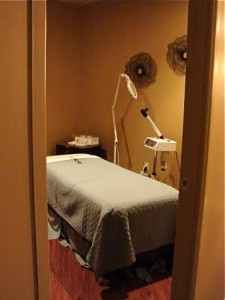
 Last month, I attended an extensive training taught by Morag Currin, author of Oncology Esthetics, A Practitioner’s Guide. I wanted to learn more about which spa treatments are safe during cancer treatments, and which may be ill-advised.
Last month, I attended an extensive training taught by Morag Currin, author of Oncology Esthetics, A Practitioner’s Guide. I wanted to learn more about which spa treatments are safe during cancer treatments, and which may be ill-advised.
Morag, founder of Touch for Cancer, is a wealth of knowledge, and I learned so much from her. The main thing I want to tell my readers is this: It’s important to feel good during and after cancer, and I believe that spa treatments-particularly massage-can help reduce side effects and produce pain-killing endorphins. It is equally important, however, to educate yourself, and find an esthetician or massage therapist that knows what he/she is doing. Particularly if you’ve had lymph nodes removed, be very cautious in your selection. A therapist who doesn’t know any better may perform the wrong technique or massage too close and increase your risk of lymphedema, a long-term condition that can create chronic and painful swelling.
“Studies of massage for cancer patients suggest massage can decrease stress, anxiety, depression, fatigue and pain,” Morag says. “A physical connection through touch is really important for any person when not feeling well, and with any health challenges as it provides comfort.”
She goes on to warn, however, that regular spa treatments and pressure may trigger lymphedema, or exacerbate an existing case of it. Other things that may put you at risk of injury include a recent surgery, fragile skin (that may tear), pain, neuropathy, wounds, or radiation burns.
The main thing to remember is to be gentle, gentle, gentle, and follow these tips:
1. Avoid all aggressive therapies during cancer treatments, including deep tissue massage, hot stone therapy, Swedish massage, Shiatsu, sports massage, and anything that feels too rough.
2. Call before you go to the spa. Ask about licenses and certifications. Check the website. And ask if anyone on staff has experience working with not only cancer patients, but you’re particular condition. Check Morag’s website for a list of certified oncology estheticians in your area.
3. Observe when you go for your appointment. Does your esthetician ask questions? At the very least, he/she should have you fill out an extensive form detailing your medical treatments including surgery, chemotherapy, radiation, lymph node removal, ports, incision locations, white blood cell count, etc. Someone who doesn’t take the time to know this about you isn’t educated-go to someone else.
4. Ask about the type of products they’re planning to use. Ask to see the bottle and the ingredient list. Allow them to use only safe and nurturing formulas that are fragrance-free and made without sulfates, phthalates, and other potentially harmful ingredients. (Take our ingredients to avoid card with you.)
5. Stop anything that feels uncomfortable. If anything hurts or feels uncomfortable to you, tell the esthetician to stop. He/she should be more than willing to listen to you and make adjustments. If not, care enough about your health to leave.
Have you found a great esthetician or massage therapist? How did you do it?
Photo courtesy the Total Woman via Flickr.com.

